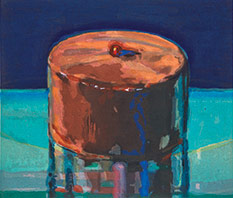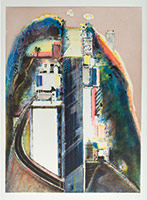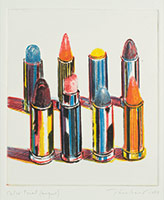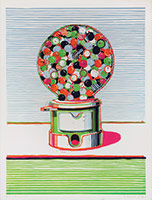A Sweet Perspective
California realist Wayne Thiebaud played a seminal role in the Pop Art movement of the 1960s.
On display at the Frederick R. Weisman Museum of Art from January 11 to March 30, Wayne Thiebaud: Works on Paper, 1948–2004 included 85 works and traces the artist’s long- standing fascination with drawing and printmaking. The exhibit, Thiebaud’s third at Pepperdine, included examples of various techniques he explored throughout his career—woodcut, etching, lithograph, screen-print, and monotype. His earliest print, dated 1948, is a modernist self-portrait inspired by Picasso. On the occasion of the exhibit, Thiebaud sat down with Weisman Museum director Michael Zakian to discuss his passion for printmaking, the California art scene, and some of his greatest influences.
MICHAEL ZAKIAN: My artist friend wanted me to ask you one very practical artist-to-artist question:
what kind of white do you use?
WAYNE THIEBAUD: Titanium. Anything that’s on sale.
MZ: A lot of the things written about you say that you started doing prints in 1964
with Crown Print Press. I was going through the marvelous collection at Sacramento
State University, and there were prints going back much earlier. In fact, we’re going
to include a self-portrait that you did in 1948 in the Weisman Museum exhibit. Do
you remember that piece?
WT: It’s an etching I printed myself years ago, one of the very early etchings that
I’ve ever done. I did some etchings on plastic very early on, just for my own first
information, but outside of that, making prints was mostly a chance to experiment
with various subject matters. And I think that’s always been the case with me. It
has to be in some measure, not just printmaking, but printmaking that relates to whatever
body of work or whatever theme I happen to be working on.
MZ: Was this at San Jose State Thiebaud studied from 1949 to 1950 or could it have been earlier?

Wayne Thiebaud, Dark Cake, 1983. Color woodblock, trial proof II, 15 x 17-1/2 inches.
All images ©Wayne Thiebaud/Licensed by VAGA, New York, NY. All rights reserved.
WT: At San Jose State, I took a class from and lithographer John Mottram, and learned to print lithography there. I did a series of things for
classroom credit, but he let me experiment and that was, I think, my first experience
with lithograph. Later on, I had a more extended experience with California lithographer Lynton Kistler in the south, who was the one who started people like and lithographer June Wayne and that whole Southern California enterprise. We brought him up to the
state fair where we could demonstrate art in action during some of those years and
some of those prints that you have the exhibit come out of that experience, as well.
MZ: It seems that, even though you were at Sacramento State a student from 1950 to 1953, there was a very active audience or interest in art at that time.
WT: We were quite lucky, because there were some people very early on that came here
and established, particularly at Sacramento City College, some serious investigations
and promotions of the art department in particular. I was fortunate enough to be hired
there for my first teaching job. That was my introduction to teaching and the whole
process there. But they’ve always been a fairly active group, developing scholarships
and sending a lot of people to places like Chouinard Art Institute and Art Center
and other places. So it was a fairly lively scene and we tried to keep it that way
by artist’s cooperative galleries and development of those kinds of things.
MZ: You have mentioned that there are some “marvelous reasons for doing prints.” What
are they?
WT: One is the notion, obviously, of transposing, where you take a very active, colorful
painting and attempt to turn it into black and white and into different sizes, different
mediums. This has always been very, very interesting to me. And along with that are
the surprises where you learn from printmaking, things that you didn’t know you were
going to learn. Not just the idea of reversals, but the idea of resolution, how strong
something can be. When you thought it was a much less strong thing, it would suddenly
show up so that these kinds of sequences have a great instructional method for even
something like painting and drawing, by slowing down a process. Since printmaking
is a sequential process, you’re of necessity slowed down to really intersperse with
some sort of critical interrogations possible.

Wayne Thiebaud, Steep Street, 1989. Spit-bite aquatint and drypoint etching. 39 x
30-1/4 inches
More important, maybe, is the idea that each medium has its unique and very special
beauty or effectiveness. There’s nothing quite like that beautiful, velvet lie of
a really fully-worked-on drypoint, where you really just scrape up that copper and
that featherly edge that catches this marvelous amount of ink, and it almost lays
on top of this process. You develop lithography in a lot of different ways.
MZ: So when you’re taking a subject and then revisiting it in a different print medium,
you are really rethinking the entire image?
WT: Yes, it’ll make you rethink it, unless you’re just into some sort of one-to-one
duplicating process, which doesn’t interest me much at all. It’s that experiment and
research potential that gives you these surprising options and sometimes disparate
results.
MZ: I know you’ve spoken very eloquently of the painters who have influenced you over
the years. I know your love of painter and printmaker Giorgio Morandi and modern artist Balthus. Were there any particular printmakers that you looked to when you were trying
to solve printmaking problems? Did you look at the great master printmakers?
WT: Yes, very much so, all the way from Goya to Degas, almost all the painters that
really took up printmaking. Not so much the technologically proficient and effective
tour de force printmakers, but artists who became printmakers. And those are quite
elegant: Whistler and Rembrandt ... there were many who were unique developers and
inventors of printmaking. What Lautrec did with lithography, for instance. I’m a very
influenced painter and printmaker and a great lover and collector of them.
MZ: Going back to your earlier career, I noticed that there was a very early exhibition
you did at the Crocker Museum: Influences on a Young Painter. What art were you looking at back then or, I should
say, have access to? Because other than the Crocker, there probably wasn’t a lot of
art for you to see in Sacramento, or was there?
WT: But I came from Los Angeles and there was quite a wonderful influence there. With
the people like and sculptor Rico Lebrun, Howard Warshaw, Billy Brice ...
MZ: Did you know them?

Wayne Thiebaud, Eight Lipsticks, 1988. Color drypoint etching, 16 x 14 inches
WT: Yes, and a whole number of people from UCLA—De Erdely and that whole group over
there. It was a very yeasty period. They had a series of galleries. I went to lectures
there where they were trying to get people to buy their prints for five dollars and
ten dollars. I was
of course just a very young student, and very easily influenced. But when I came to
Sacramento then, I had that experience, plus being close to San Francisco and getting
to spend time at the San Francisco Museum of Modern Art.
MZ: I noticed one interview with you where you mention some influences early on as being
John Marron and Picasso, and you also mentioned C. S. Price. That’s not a name you
hear often.
WT: No, not a name you hear much, but he was quite a fascinating figure up in the north.
I never did meet him, but I did hear wonderful stories about him, and finally went
up and saw his carved little animals that he used.
MZ: You have always been more interested in art, and the history of art, and the technique
of art, rather than just that pop-art phenomenon that people have always associated
you with. I was looking at some dates and I saw one thing really interesting. When
you started doing the food paintings and showing them with Allan Stone in 1962 or
so, there was a fascinating drawing book that came out around the same time. Did you
know Robert Beverly Hale and that great book he did,Drawing Lessons of the Great Masters? One thing he did was begin looking at the simple volumes that underlie complex old
master figure drawing. And in a way, at the same time, I think you were doing something
very similar with your food paintings, getting down to those core shapes.
WT: Yes, I never did think of the food paintings so much as anything but actually traditional
painting problems and ways of using them compositionally, which alerted me to real
possibilities. I didn’t think of any irony or any of the things people wrote about
so laboriously. I’ve thought of myself and think of myself as quite a traditional
painter in a really full sense. While I’m very interested in contemporary art and
the whole idea of modernism, I think we’re still trying to sort out just what was
good about modernism, as well as what was pretty destructive and not such a good happenstance.
Most painters in my opinion, at some point to some degree are really retrograde, and
we need that if we’re going to have museums and value standards where we have consensus
and some kind of value structure, then I think that tradition of paying attention
to art history is crucially important. All the painters I knew who were any good were
terrific lovers of art history, as well.
MZ: Speaking of force, there were some early prints that I just love. The woodcuts you
were doing around ’62, ’64. I think Sacramento State has the yo-yos and the sucker
tree and the half-cakes. They’re so elemental and so essential. I guess that gets
down to your interest in the graphic language of art.
WT: Very much so. I’m very interested in and have a great respect for good graphic designers
and typographers, since I particularly came out of commercial art. I think that’s
elemental and very, very much to do with the whole concept of design and how important
drawing and design are.

Wayne Thiebaud, Gumball Machine, 1971. Color linocut, unique trial proof, 24-1/4 x
18 inches
MZ: One thing that always fascinated me was that when you were at Rexall Drugs in L.A.,
you were there with Robert Mallary. Now most people like me know his assemblage sculptures.
But what was he doing, what were you doing at that time, what were the influences
in the late ‘40s?
WT: We were both working at the Rexall Drug Company and he was working just in the production
department. He didn’t have much of a role in designing and I always thought of myself
as a hotshot art director and started talking one day about Cezanne, and particularly
Erle Loran’s book on Cezanne’s composition and he just shaped me up and just said,
“That’s so elemental. Why don’t you really take it on?” We’ve been great friends and
he actually was largely responsible for shaping me up and getting me to read more
and told me how dumb I was, and was a terrific analytic critic, incidentally. He was
a great mentor and inspiration for me, so he was very largely responsible for getting
me much more seriously dedicated to how difficult and how wondrous painting was and,
“Be sure and be responsible not to ignoble that great tradition,” he used to say.
